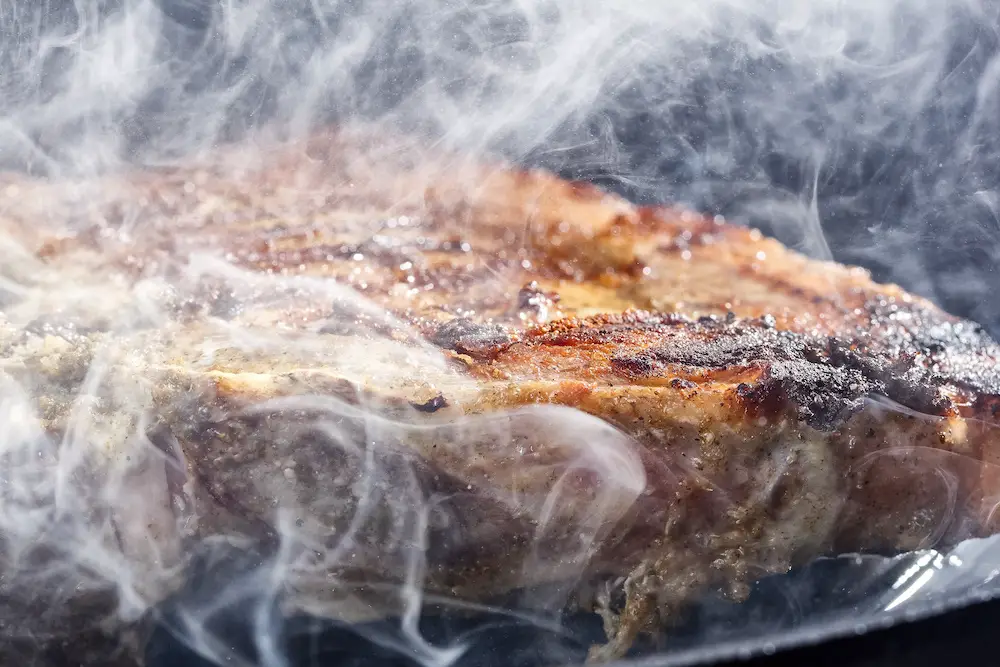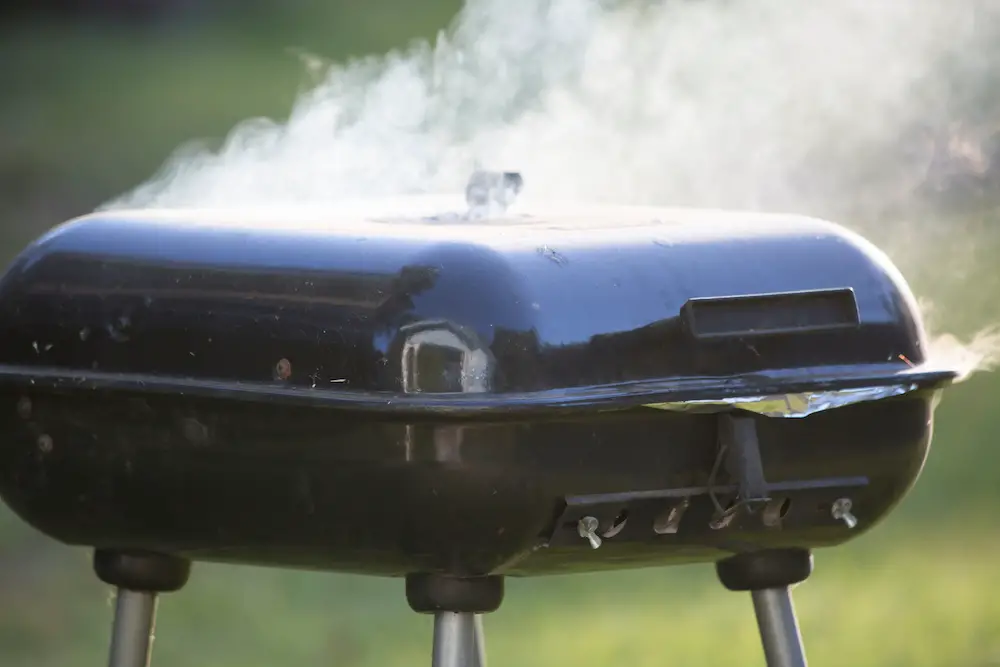
Wondering what color should smoke be when smoking meat? Not a lot of people ask this question when cooking meat in smokers.
Instead, they focus more on the amount of smoke produced, believing that the more smoke, the better.
In truth, expert pitmasters aim for less smoke.
Since it serves as a seasoning for the meat, too much smoke aroma will overpower the flavors you want to achieve.
The color of the smoke can also tell if the meat will taste good or bad. So, how do you maintain the right color?
What Color Should Smoke Be When Smoking Meat?
When there’s fire, lots of smoke follows. Its color can vary from white, gray, blue, brown, and even black.
However, you need to know that not all smoke is “good,” especially when cooking meat.
Smokers and grills use electricity, gas, or charcoal to produce heat. Dry wood is then added to generate smoke and impart flavor to the meat.
The color of the smoke you need to achieve to get the best flavor for your meat is what’s called the “thin blue smoke.”
If you see gray smoke, black smoke, or any other color, you could expose your meat to dirty smoke, which will negatively affect its flavor.
Keep in mind that sometimes white smoke can be acceptable if you are using an electric smoker.
Because of how an electric smoker causes the wood chips to smolder, white smoke is normal, but keep the vents fully open to prevent bitterness.
How To Achieve the Thin Blue Smoke When Cooking
It takes time and effort to achieve that perfect smoke color when cooking meat in a smoker.
In a nutshell, you need to know how to properly set up your smoker to make sure that you’re getting just the right amount and color of smoke.
We listed down a few simple tips to help you achieve that thin blue smoke and impart amazing flavors to your meat.
1. A Little Smoke Is Good Enough
Seeing thick smoke coming out of your smoker is not a good thing.
If you see a lot of smoke coming out of the smoker, you are probably injecting too much taste of smoke into your meat.
More often than not, it will overpower the meat and leave a bitter taste.
What you are aiming for is barely visible smoke coming out the smoker’s exhaust vent. If you are having a hard time spotting the smoke, you’re doing a good job.
Plumes of white smoke coming from the smoker indicate an incomplete combustion process, so you need to manage your fire to get that thin smoke going correctly.
2. Properly Build Your Fire
When cooking meat in a smoker, you need to make sure that you focus on the heat source.
In a charcoal smoker, your main heat source would be charcoal; the chunks of wood are only added to produce smoke.
Here are a few tips for maintaining your fire properly and preventing thick smoke from forming:
- Start with a good burning bed of charcoal; this also applies to stick-burning smokers.
- Add small amounts of charcoal to your fire to burn evenly, preventing temperature spikes and dirty smoke.
- Only add wood chunks when your fire is burning well. Adding wood too soon could lower the temperature and produce creosote.
- Only add a few chunks of wood at a time. Start by adding two pieces each time until you get familiar with your smoker.
- Maintain a good charcoal to wood ratio. Charcoal is a clean, hotter burning fuel so keep the correct amount in your fire.
- Make sure all your fuel is dry. Damp or wet wood will steam.
- Light your fuel in a grill or charcoal chimney before adding it to your smoker. Keep a small charcoal grill next to your smoker and light larger pieces of lump charcoal for the cleanest burn. Next, add them a few at a time with fireplace tongs. This is a great way to maintain a great temperature and clean smoke.

3. Use the Right Wood
The species of wood you use can affect the taste of the meat you’re cooking.
While there are wood species perfect for smoking, there are also ones you should avoid.
Since you’re dealing with food, you should never use wood that has been treated, such as particle boards, treated lumber, or plywood.
Wood with a lot of resin or pitch is also not a good choice, including cedar, evergreens, pine, and more.
However, you can mix different species of wood for cooking to inject a more distinct flavor into your meat.
You can achieve different flavors by tweaking the exact mixture of woods you use for smoking meat.
Mesquite provides a strong and distinctive taste profile. Another advantage of mesquite is using fewer wood chunks to achieve a great smoky flavor.
If you want your meat to achieve a more mellow taste, you can combine it with hickory, a type of wood that offers a less robust flavor.
You can also use nut woods and fruit woods as they offer a sweeter flavor.
4. Proper Air Flow Management
Earlier, we’ve mentioned that you need to manage your fire when the smoke starts to thicken.
The best way to do this is through proper airflow management.
Don’t panic if you suddenly see thick white smoke from the smoker; you can simply adjust the airflow until you get the right amount of smoke.
You need enough air in the cooking chamber for chemical reactions to happen and achieve complete combustion.
However, allowing too much oxygen supply can make the fire burn quickly, which would result in incomplete combustion.
The best way to control the air intake is to keep the exhaust vent fully open. As for temperature control, you can control the heat through the intake vent.
5. Keep Your Smoker Clean
A clean smoker is an essential part of smoking meat and a task that even experienced pitmasters don’t want to do.
No matter how good the smoke is, creosote can still build up in your smoker.
Creosote is the byproduct of incomplete combustion that can impart a bitter flavor to food.
If you don’t want to serve sooty food, you have to take your time and clean your smoker regularly.
Cleaning your smoker can also help you spot rusted parts and deal with them early on, saving your smoker from damage.
After removing creosote from your smoker, always take a few minutes to reseason your smoker with a quick hot, dry smoke.
When Smoking Meat, Practice Is King
If someone asks, “What color should smoke be when smoking meat?” you know how to answer, “thin blue smoke.”
Knowing the color and thickness of the smoke can give you a head start if it’s your first-time cooking meat in your smoker.
However, with a lot of practice, you will be able to observe the smoke as it exits your smoker and know what adjustments to make.
One final note, always error on less smoke. You might be surprised at how little visible smoke it takes to get great smoky flavors in your food.
We hope the knowledge in this article will help you achieve success.
